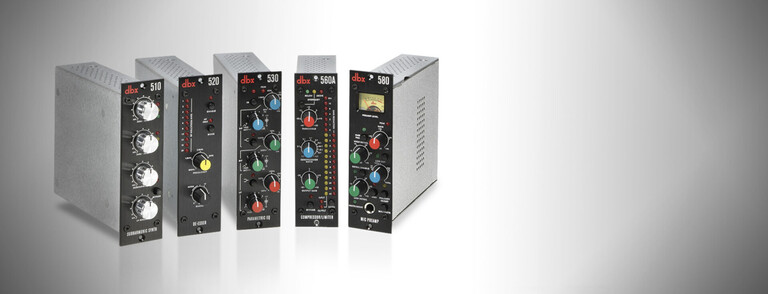
The good news for us as engineers is that the dbx 160A as well as many of dbx’s popular audio circuits are available in a format more accessible than ever – the 500 series format! Simply slot these modules into your rack of choice and you can track, mix, and process your audio files using authentic dbx hardware.
In this guide, we’re going to be taking a look at the modules on offer from dbx and explain how they can be used in your setup during tracking and mixing.
The 510 is based off of another renowned audio processor design by dbx, the 120A. It’s called a subharmonic synthesizer and it takes an audio signal and generates low-end subharmonics to create an extended low frequency response. This is much more than an EQ, it’s an instrument in itself that adds its own synthesised bass note, exactly an octave below the bass in the original audio.
The 510 has two separate bands of subharmonic synthesis that provide the best combination of smoothness and control in the low-end with two independent frequency ranges. There’s also an independent Low Frequency Boost circuit that is used to even-out the bass output of the processed signal and fill in the “gap” between the synthesized low bass (below 56 Hz) and the mid bass of the original source.
The 510 produces musical low frequencies that don’t interfere with mid and high-band information, even when the maximum synthesis and boost are applied. The result is a low-end punch that people really feel and a sound that fills out the low-end of your mix and subsequently the dance floor!

Based on another dbx classic, the 902, the 520 De-esser is a simple but powerful device that tames the sibilant frequencies of vocals and other instruments without removing excessive high-end and ‘dulling’ the sound.
Featuring variable frequency and ‘range’ controls, the 520 can be tuned-in to problem areas in a Vocal performance (typically “ess” sounds in the 3k to 8k area depending on the vocalist) and then compress those frequencies to make them less prominent. The key with any De-esser is to remove those problem areas without taking away too much high-end from the vocals and making them sound unnatural. With the 520 and it’s unique range control, you can determine your maximum gain reduction – ensuring that only a enough sibilance is removed so that the words remain intelligible.
Featuring a wider frequency range than most de-essers as well as a unique wide-band mode, the 520 is equally as useful on other instruments such as guitars and drums to remove problematic HF frequencies and make space in the frequency spectrum.

The dbx 530 is a 3-band, Parametric EQ with more options than most other 500 series units thanks to it’s dual-concentric controls and packed-in front panel!
Based upon the classic dbx 905, the dbx 530 is a fully parametric EQ with three overlapping filter bands featuring controls for frequency and bandwidth (Q) as well as up to 15dB of cut or boost for aggressive EQ-ing.
Each band has discrete controls as well as an option for “infinite notch” that can be used to surgically cut-out problematic frequencies. There’s also a shelving option on the high and low bands for even more tonal versatility!
The 520 is most certainly an invaluable utilitarian tool that you can use to shape sources during tracking or mixing!

The dbx 560A Compressor/Limiter features true dbx heritage poured into a 500 series module. Featuring the legendary VCA-based compression that dbx pioneered back in 1976, the 560A shares commonality with the now legendary, wood-panelled, dbx 160.
Featuring the same OverEasy® and Hard Knee compression curves found in the industry-standard dbx 160A rackmount processor, the dbx 560A is a workhorse compressor featuring an extremely wide-ranging threshold, ratio, and output controls as well as RMS level detection.
A unique feature to the 560A is its inverse-compression modes that decreases the output level when the input exceeds a threshold – perfect for critical recording where clipping is not an option such as during broadcast.
Designed to provide compression effects ranging from natural-sounding dynamic smoothing, to punchy drums and bass, to aggressive "brick wall" peak limiting, the 560A is versatile enough for any source.

The dbx 580 is more than a microphone preamp. It’s a preamp and instrument DI with two ‘detail’ EQ bands that can help shape your sources during tracking.
Offering a sonically-transparent preamp that compliments even the most esoteric microphones, the 580A will transform low-sensitivity dynamic and ribbon microphones into high level, high current outputs for connection to your audio interface or mixer.
With 60dB of gain on tap, the 580A also features a variable-frequency Low-Cut Filter used to reduce low-end rumble as well as a Low and High Detail Equalization Controls that help shape the source on the way into the box. The low-detail control features a “Pultec-style" cut/boost curve with a steep cut at the corner frequency followed by a generous low-end boost from below 200hz – helping to boost low-end whilst cutting muddiness and boxiness.
Alongside the unique features, there is the standard selection of phantom power, PAD, and Polarity switches culminating in a preamp that adds warmth and definition to your microphones.

This new blog is presented by the team at Sound Technology Ltd, a leading distributor of musical instruments and pro audio equipment in the UK and ROI.